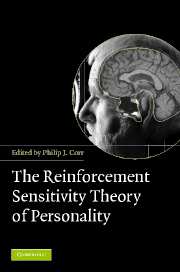Book contents
- Frontmatter
- Contents
- List of abbreviations
- List of figures
- List of tables
- List of contributors
- Preface
- 1 Reinforcement Sensitivity Theory (RST): introduction
- 2 The neuropsychology of fear and anxiety: a foundation for Reinforcement Sensitivity Theory
- 3 Animal cognition and human personality
- 4 The behavioural activation system: challenges and opportunities
- 5 Reinforcement Sensitivity Theory and personality
- 6 Reinforcement sensitivity scales
- 7 Performance and conditioning studies
- 8 Psychophysiological studies
- 9 Reinforcement Sensitivity Theory and mood induction studies
- 10 Neuro-imaging and genetics
- 11 Reinforcement Sensitivity Theory and psychosomatic medicine
- 12 RST and clinical disorders: anxiety and depression
- 13 RST and psychopathy: associations between psychopathy and the behavioral activation and inhibition systems
- 14 Behavioural activation and inhibition in social adjustment
- 15 Reinforcement sensitivity in the workplace: BIS/BAS in business
- 16 Formal and computational models of Reinforcement Sensitivity Theory
- 17 Reinforcement Sensitivity Theory: a critique from cognitive science
- 18 The contribution of Reinforcement Sensitivity Theory to personality theory
- General Index
- Index of Names
- References
17 - Reinforcement Sensitivity Theory: a critique from cognitive science
Published online by Cambridge University Press: 31 January 2011
- Frontmatter
- Contents
- List of abbreviations
- List of figures
- List of tables
- List of contributors
- Preface
- 1 Reinforcement Sensitivity Theory (RST): introduction
- 2 The neuropsychology of fear and anxiety: a foundation for Reinforcement Sensitivity Theory
- 3 Animal cognition and human personality
- 4 The behavioural activation system: challenges and opportunities
- 5 Reinforcement Sensitivity Theory and personality
- 6 Reinforcement sensitivity scales
- 7 Performance and conditioning studies
- 8 Psychophysiological studies
- 9 Reinforcement Sensitivity Theory and mood induction studies
- 10 Neuro-imaging and genetics
- 11 Reinforcement Sensitivity Theory and psychosomatic medicine
- 12 RST and clinical disorders: anxiety and depression
- 13 RST and psychopathy: associations between psychopathy and the behavioral activation and inhibition systems
- 14 Behavioural activation and inhibition in social adjustment
- 15 Reinforcement sensitivity in the workplace: BIS/BAS in business
- 16 Formal and computational models of Reinforcement Sensitivity Theory
- 17 Reinforcement Sensitivity Theory: a critique from cognitive science
- 18 The contribution of Reinforcement Sensitivity Theory to personality theory
- General Index
- Index of Names
- References
Summary
Reinforcement Sensitivity Theory (RST) draws on forty years of research conducted by Jeffrey Gray, and now incorporates significant modifications introduced by Philip Corr, Alan Pickering, Neil McNaughton and others (see Corr 2004; McNaughton and Corr 2004). RST is now a highly visible feature of the panorama of models of human personality. The purpose of this chapter is to provide a critique of the theory, from a cognitive science standpoint. RST is an ambitious, multifaceted account of the biological bases of personality, comprising several ‘theories within a theory’. Table 17.1 discriminates the logically distinct facets of RST, whose validity may be separately evaluated, as follows.
First, there is an epistemological facet. RST is based on animal models of emotion and motivation (McNaughton and Gray 2000); one may question whether such models are valid for understanding human personality. Secondly, there is a neurophysiological facet. RST sets out a ‘conceptual nervous system’ or a specification of discrete brain systems that influence personality. Figure 17.1 illustrates the three fundamental systems specified by the latest, modified version of RST (Corr 2004). The Fight-Flight-Freeze System (FFFS) mediates reactions to all aversive stimuli, including both conditioned and unconditioned stimuli. It relates to fear, but not anxiety. The behavioral activation system (BAS) mediates reactions to conditioned and unconditioned appetitive stimuli. In the current theory, the behavioral inhibition system (BIS) is activated by goal conflict, typically when the organism faces an approach-avoidance conflict associated with concurrent activation of the FFFS and BAS. Its activation corresponds to anxiety and worry, but not fear.
- Type
- Chapter
- Information
- The Reinforcement Sensitivity Theory of Personality , pp. 482 - 507Publisher: Cambridge University PressPrint publication year: 2008
References
- 14
- Cited by



